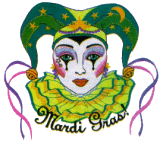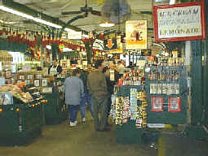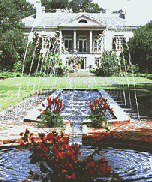New Orleans is probably best known for its Mardi Gras celebration, which it has been holding annually since 1837. The origin of the festival stems from 1827, when a group of students had recently returned from Paris, where  carnival celebrations were held. The students dressed in strange costumes and danced through the streets, to the amusement of spectators. This tradition continued until 1833, with the festivities growing larger every year, and culminating with a ball on Fat Tuesday. In 1833, a large plantation owner solicited funds to organize the celebration, but it was not until four years later that the first official Mardi Gras parade would be held. Today, the festival season begins on January 6th, which is also referred to as the Twelfth Night, with private masked balls which continue to be held until Mardi Gras Day, which is also referred to as Fat Tuesday. It always falls on the day before Ash Wednesday. Parades are held throughout the season and consist of marching bands and floats holding celebrity krewe members, who throw traditional beads, doubloons and assorted items to the people lining the streets. carnival celebrations were held. The students dressed in strange costumes and danced through the streets, to the amusement of spectators. This tradition continued until 1833, with the festivities growing larger every year, and culminating with a ball on Fat Tuesday. In 1833, a large plantation owner solicited funds to organize the celebration, but it was not until four years later that the first official Mardi Gras parade would be held. Today, the festival season begins on January 6th, which is also referred to as the Twelfth Night, with private masked balls which continue to be held until Mardi Gras Day, which is also referred to as Fat Tuesday. It always falls on the day before Ash Wednesday. Parades are held throughout the season and consist of marching bands and floats holding celebrity krewe members, who throw traditional beads, doubloons and assorted items to the people lining the streets.
The Audubon Zoo in New Orleans houses over 1,500 specimens of animals from throughout the world. Realistic environments have been created for  housing the animals, including an Australian Outback, African Savanna and a Louisiana Swamp. In the swamp exhibit, visitors will find one most extensive collections on swamp wildlife, including the world's only white alligators. New to the zoo, is the recent addition of the Komodo Dragon, and Jaguar Jungle, an exhibit that ties together the animals, people, environment and culture of the Maya civilization in a jungle rainforest setting. housing the animals, including an Australian Outback, African Savanna and a Louisiana Swamp. In the swamp exhibit, visitors will find one most extensive collections on swamp wildlife, including the world's only white alligators. New to the zoo, is the recent addition of the Komodo Dragon, and Jaguar Jungle, an exhibit that ties together the animals, people, environment and culture of the Maya civilization in a jungle rainforest setting.
Jackson Square sits in the center of the French Quarter, which was founded in 1718. The square was originally called the Place d`Armes, and was used as to  train, drill and parade military groups. It was also the site of public executions, including hanging, beheading, burning at the stake and breaking on the wheel. In 1850, the square was renamed to Jackson Square, in honor of Andrew Jackson, the hero of the battle of New Orleans. A statue of Jackson on horseback stands in the center of the park, with an inscription in the base declaring "The Union must and shall be preserved." Today the park is filled with people daily, including artists and various street performers, such as musicians, acrobats, tap dancer, jugglers, tarot card readers and mimes. train, drill and parade military groups. It was also the site of public executions, including hanging, beheading, burning at the stake and breaking on the wheel. In 1850, the square was renamed to Jackson Square, in honor of Andrew Jackson, the hero of the battle of New Orleans. A statue of Jackson on horseback stands in the center of the park, with an inscription in the base declaring "The Union must and shall be preserved." Today the park is filled with people daily, including artists and various street performers, such as musicians, acrobats, tap dancer, jugglers, tarot card readers and mimes.
On the edge of Jackson Square stands the Cathedral of Saint Louis, King of  France. The cathedral that stands today is actually the third building to occupy the site. The original church was destroyed during a hurricane in 1722. A new church was erected in it's place, but succumbed to the fire of 1788, which destroyed nearly every structure in the French Quarter. The present day church was constructed soon after the fire with funds donated by Don Almonaster. Shortly afterwards, in 1793, the church was designated as a cathedral. France. The cathedral that stands today is actually the third building to occupy the site. The original church was destroyed during a hurricane in 1722. A new church was erected in it's place, but succumbed to the fire of 1788, which destroyed nearly every structure in the French Quarter. The present day church was constructed soon after the fire with funds donated by Don Almonaster. Shortly afterwards, in 1793, the church was designated as a cathedral.
The French Market is the oldest city market in the United States. It began as an Indian trading post and meeting place by the Choctaw Indians, before europeans  settled in the area. The Spanish constructed the first buildings for the market in 1771, which were destroyed by a hurricane in 1812. Shortly afterward, new structures were erected to replace the original buildings. The same buildings still stand today, and house offices, shops and eating establishments. In the early morning, chefs from the best local restaurants come to the market to get the freshest produce and meats. On the weekends the market is transformed into a giant flea market, welcoming vendors from across the state. settled in the area. The Spanish constructed the first buildings for the market in 1771, which were destroyed by a hurricane in 1812. Shortly afterward, new structures were erected to replace the original buildings. The same buildings still stand today, and house offices, shops and eating establishments. In the early morning, chefs from the best local restaurants come to the market to get the freshest produce and meats. On the weekends the market is transformed into a giant flea market, welcoming vendors from across the state.
Longue Vue mansion was designed by William and Geoffrey Platt, borrowing  from the Classical Revival styling of southern Louisiana classic architecture. The beautiful estate was home to Edgar Bloom Stern, a successful cotton broker and his wife, the daughter of Sears Roebuck magnate, Julius Rosenwald. The interior of the mansion contains it's original furnishings of English and Americana antiques from the 18th-century. Outside, the eight acre estate is filled with gardens. The central garden is the Spanish Court, reminiscent of a 14th-century Spanish garden. Other gardens on the estate include Pan, the Portico, the Walled Gardens, the Yellow Garden, the Canal Garden, and the Pond Garden, the Herb Maze, and the Butterfly Garden. from the Classical Revival styling of southern Louisiana classic architecture. The beautiful estate was home to Edgar Bloom Stern, a successful cotton broker and his wife, the daughter of Sears Roebuck magnate, Julius Rosenwald. The interior of the mansion contains it's original furnishings of English and Americana antiques from the 18th-century. Outside, the eight acre estate is filled with gardens. The central garden is the Spanish Court, reminiscent of a 14th-century Spanish garden. Other gardens on the estate include Pan, the Portico, the Walled Gardens, the Yellow Garden, the Canal Garden, and the Pond Garden, the Herb Maze, and the Butterfly Garden. |

 carnival celebrations were held. The students dressed in strange costumes and danced through the streets, to the amusement of spectators. This tradition continued until 1833, with the festivities growing larger every year, and culminating with a ball on Fat Tuesday. In 1833, a large plantation owner solicited funds to organize the celebration, but it was not until four years later that the first official Mardi Gras parade would be held. Today, the festival season begins on January 6th, which is also referred to as the Twelfth Night, with private masked balls which continue to be held until Mardi Gras Day, which is also referred to as Fat Tuesday. It always falls on the day before Ash Wednesday. Parades are held throughout the season and consist of marching bands and floats holding celebrity krewe members, who throw traditional beads, doubloons and assorted items to the people lining the streets.
carnival celebrations were held. The students dressed in strange costumes and danced through the streets, to the amusement of spectators. This tradition continued until 1833, with the festivities growing larger every year, and culminating with a ball on Fat Tuesday. In 1833, a large plantation owner solicited funds to organize the celebration, but it was not until four years later that the first official Mardi Gras parade would be held. Today, the festival season begins on January 6th, which is also referred to as the Twelfth Night, with private masked balls which continue to be held until Mardi Gras Day, which is also referred to as Fat Tuesday. It always falls on the day before Ash Wednesday. Parades are held throughout the season and consist of marching bands and floats holding celebrity krewe members, who throw traditional beads, doubloons and assorted items to the people lining the streets.
 housing the animals, including an Australian Outback, African Savanna and a Louisiana Swamp. In the swamp exhibit, visitors will find one most extensive collections on swamp wildlife, including the world's only white alligators. New to the zoo, is the recent addition of the Komodo Dragon, and Jaguar Jungle, an exhibit that ties together the animals, people, environment and culture of the Maya civilization in a jungle rainforest setting.
housing the animals, including an Australian Outback, African Savanna and a Louisiana Swamp. In the swamp exhibit, visitors will find one most extensive collections on swamp wildlife, including the world's only white alligators. New to the zoo, is the recent addition of the Komodo Dragon, and Jaguar Jungle, an exhibit that ties together the animals, people, environment and culture of the Maya civilization in a jungle rainforest setting.
 train, drill and parade military groups. It was also the site of public executions, including hanging, beheading, burning at the stake and breaking on the wheel. In 1850, the square was renamed to Jackson Square, in honor of Andrew Jackson, the hero of the battle of New Orleans. A statue of Jackson on horseback stands in the center of the park, with an inscription in the base declaring "The Union must and shall be preserved." Today the park is filled with people daily, including artists and various street performers, such as musicians, acrobats, tap dancer, jugglers, tarot card readers and mimes.
train, drill and parade military groups. It was also the site of public executions, including hanging, beheading, burning at the stake and breaking on the wheel. In 1850, the square was renamed to Jackson Square, in honor of Andrew Jackson, the hero of the battle of New Orleans. A statue of Jackson on horseback stands in the center of the park, with an inscription in the base declaring "The Union must and shall be preserved." Today the park is filled with people daily, including artists and various street performers, such as musicians, acrobats, tap dancer, jugglers, tarot card readers and mimes.
 France. The cathedral that stands today is actually the third building to occupy the site. The original church was destroyed during a hurricane in 1722. A new church was erected in it's place, but succumbed to the fire of 1788, which destroyed nearly every structure in the French Quarter. The present day church was constructed soon after the fire with funds donated by Don Almonaster. Shortly afterwards, in 1793, the church was designated as a cathedral.
France. The cathedral that stands today is actually the third building to occupy the site. The original church was destroyed during a hurricane in 1722. A new church was erected in it's place, but succumbed to the fire of 1788, which destroyed nearly every structure in the French Quarter. The present day church was constructed soon after the fire with funds donated by Don Almonaster. Shortly afterwards, in 1793, the church was designated as a cathedral.
 settled in the area. The Spanish constructed the first buildings for the market in 1771, which were destroyed by a hurricane in 1812. Shortly afterward, new structures were erected to replace the original buildings. The same buildings still stand today, and house offices, shops and eating establishments. In the early morning, chefs from the best local restaurants come to the market to get the freshest produce and meats. On the weekends the market is transformed into a giant flea market, welcoming vendors from across the state.
settled in the area. The Spanish constructed the first buildings for the market in 1771, which were destroyed by a hurricane in 1812. Shortly afterward, new structures were erected to replace the original buildings. The same buildings still stand today, and house offices, shops and eating establishments. In the early morning, chefs from the best local restaurants come to the market to get the freshest produce and meats. On the weekends the market is transformed into a giant flea market, welcoming vendors from across the state.
 from the Classical Revival styling of southern Louisiana classic architecture. The beautiful estate was home to Edgar Bloom Stern, a successful cotton broker and his wife, the daughter of Sears Roebuck magnate, Julius Rosenwald. The interior of the mansion contains it's original furnishings of English and Americana antiques from the 18th-century. Outside, the eight acre estate is filled with gardens. The central garden is the Spanish Court, reminiscent of a 14th-century Spanish garden. Other gardens on the estate include Pan, the Portico, the Walled Gardens, the Yellow Garden, the Canal Garden, and the Pond Garden, the Herb Maze, and the Butterfly Garden.
from the Classical Revival styling of southern Louisiana classic architecture. The beautiful estate was home to Edgar Bloom Stern, a successful cotton broker and his wife, the daughter of Sears Roebuck magnate, Julius Rosenwald. The interior of the mansion contains it's original furnishings of English and Americana antiques from the 18th-century. Outside, the eight acre estate is filled with gardens. The central garden is the Spanish Court, reminiscent of a 14th-century Spanish garden. Other gardens on the estate include Pan, the Portico, the Walled Gardens, the Yellow Garden, the Canal Garden, and the Pond Garden, the Herb Maze, and the Butterfly Garden.















